
Gardaí at Bray Garda Station are investigating an attempted robbery that occurred on 7th December 2023 at approximately 11:30am at the Post Office in Kilcoole, Co. Wicklow.
On the date in question, shortly after 11am, a black Mazda 3, carrying two male suspects, drove into the village of Kilcoole, from the direction of Greystones. The car drove around the village a number of times before parking on New Road, adjacent to the Post Office.
One of the men walked across New Road, onto Main Street in the direction of the Post Office. He entered the post office and produced a handgun, from his pocket, in his left hand. He then threatened the staff member. The suspect did not get any money from the assistant, and left saying he would return. The suspect walked around Kilcoole village for approximately 5 minutes before returning to the black Mazda 3. The two suspects then left in the same direction they had come from.
Garda Appeal
- Were you in the Kilcoole, Co. Wicklow area on 7th December 2023 at approximately 11am and do you recall seeing anything suspicious?
- Gardaí are asking the local community if they have any information about this crime.
- Do you recall seeing a black Mazda 3 in the Kilcoole area on the 7th December?
- Can you identify the suspects in the CCTV and below descriptions?
Description of Suspects:
Suspect 1:
- 5’ 8’’ - 5’ 10’’
- Medium - Stocky build
- Black jacket
- Black hat and gloves
- Black bottoms
- Black runners
Suspect 2 (Driver of Vehicle):
- Blue fisherman’s hat
- Hunting/ camouflage jacket with a fur lined hood
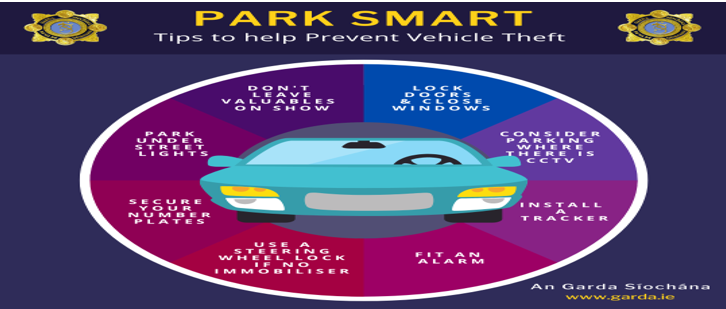
On this month’s Crimecall, Sergeant John Fitzpatrick was in studio to discuss vehicle theft prevention advice.
Theft of vehicles increased significantly in 2022, with over 4,000 theft incidents being reported. There was a 21% increase in the number of incidents reported during 2023 (4978 incidents reported) in comparison to 2022.
During 2023, the majority of reported incidents occurred between 6pm and 4am, which accounted for almost 60% of incidents.
Since 1998, immobilisers have been installed in all new vehicles for sale in the EU. Immobilisers work by restricting an essential component part of the engine unless the correct key is used to start the vehicle. They are very effective in reducing vehicle theft.
If you have a vehicle without an immobiliser, you should consider having one retro fitted. Many immobilisers now work in conjunction with an alarm. Therefore, if an attempted theft is made to your vehicle it will not start and the alarm will sound.
Various other security devices are also available that you can consider installing to protect your vehicle:
Steering wheel locks work by simply locking onto the steering wheel preventing the steering wheel from turning. They also act as a visual deterrent as most are yellow in colour and are clearly visible from outside the vehicle.
External wheel lock or clamps can also be fitted onto the wheel of the vehicle along with handbrake locks, gear stick locks and pedal locks which often have an additional alarm function.
All these items act as a deterrent and can make your vehicle less attractive to criminals.
Keyless Entry
Many modern vehicles utilise a keyless entry system. They work by sending a signal between the key and the vehicle. Relay signal theft can occur when the signal of the key is mimicked and used to gain entry to a vehicle. In order to prevent the key signal transmitting while away from the vehicle, the key can be placed in a Faraday bag or box or even a biscuit tin for storage. By doing so, these items restrict the radio signal from being emitted from the key and reduce the risk of it being copied.
Theft from Vehicles
In order to mitigate against the risk of theft from your vehicle always lock and double check the security of the doors and windows. You should remove all valuable items from your vehicle. However, if you must store valuable items in the vehicle consideration should be given to enhancing the locking systems and installing a GPS tracker. In addition, a sensor linked to your house alarm can be fitted to the vehicle and activate when you are at home. Consideration could also be given to fitting a secure locked storage chest or cage vault within vans.
General vehicle safety advice:

- Buyers should check the security features of vehicles and make decisions relating to augmenting security
- A visible steering wheel lock or chain should be considered
- Leave expensive property at home or work, if not required
- If you must leave valuables in a vehicle, do not leave them on show - A good idea is to leave an empty glove box open, showing would-be criminals that there is nothing for them to steal.
- Lock doors and fully close windows. Don’t be tempted to leave the windows slightly open.
- Fit an alarm
- Fit an immobiliser or use a physical lock
- Install a tracker
- Use a catalytic convertor lock
- Park under streetlights or in a secure carpark
- Park where there is CCTV, when possible
- Fit theft-resistant number plate fittings
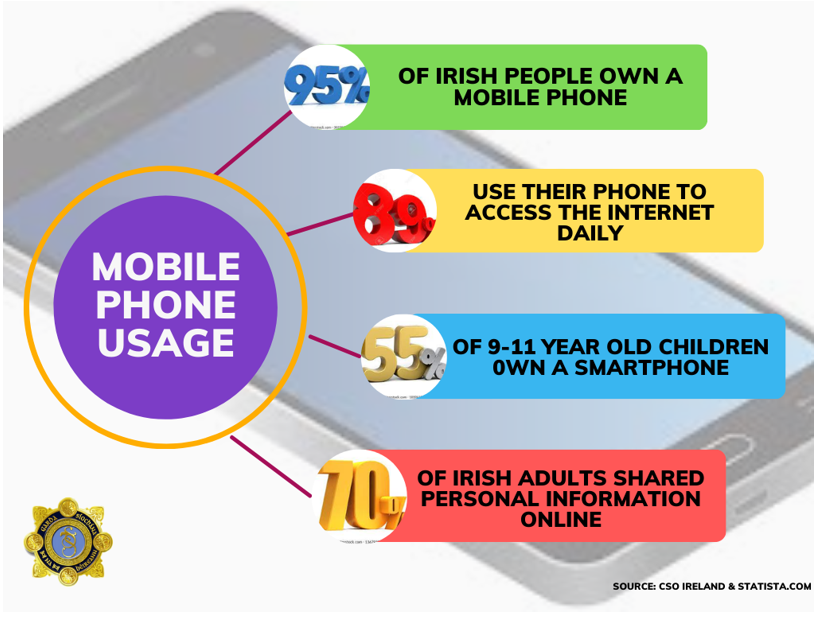
A 2023 survey found that there are 700,000 more mobile phone subscriptions in Ireland than there are people. Mobile phones have replaced laptops as the primary device we use to connect online - 95% of people have a mobile phone, while almost 90% of people access the internet every day using their phones to connect to the internet, social media and email. At the same time, over 55% of children aged 9-11 own a smartphone which connects them to social media and the internet, often without restriction or supervision. A survey by Webwise found that 65% of parents are unaware of their child’s online activity. We forget that mobile phones are a storage device, a processing computer, a photo gallery, a navigation aid, a mobile bank and a communication hub all combined. Most people use mobile phones for more reasons than any other device they have access to.
Because the phone is in our pocket we believe it is secure and safe. But that’s not always the case.They are nearly always on and connected to a network and the Internet. Insecure Wi-Fi doesn’t necessarily encrypt the personal data we send and doesn’t always require a password or other form of credential to be entered. At the same time, our phones are designed to connect to other devices through Wi-Fi or Bluetooth. This allows files and data to be shared between devices and transfer files very easily.
It has been recognised that our phones carry valuable data and are being targeted by organised criminal groups (O.C.G) - resulting in the data being stolen. Mobile phishing emails have increased by 85%, while many O.C.G’s are creating fake apps that are designed to capture your interest and then your personal information. We make that easier if we don’t update our mobiles with official software patches, anti-virus protections or just lock it down by turning off connection apps such as Bluetooth unless you actually need to use them. Around 60% of people update protections on their mobiles regularly, with many workers expecting their IT section organise the updates for them.
Most mobile phone suppliers provide annual system upgrades and regular updates to software to include patches and fixes for bugs which improve performance and security. Users are asked to permit the upgrade which can be rejected or delayed because it can change features on the phone, but that increases the risk of infection with malware or a cyber-attack. We should always check for updates ourselves.
Basic Rule of Mobile Phone Usage
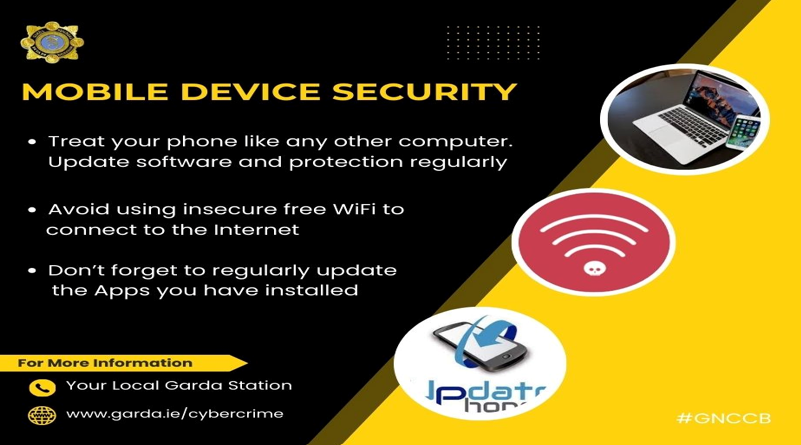
- Treat your phone as a computer
- Update your phone’s software and virus protections regularly
- Only install known and trusted apps
- Avoid using unsecure free Wi-Fi to connect your phone to the internet or a work network
- Use a separate password or biometric logon such as a fingerprint to lock your phone
- Turn on encryption on your Android phone. You can find out how by searching on Google (With Android its Settings & Security) iPhones have encryption by default when protected with a password or other lock.
More Information and help
You can get more information about mobile security from your service provider, by searching online and from the Garda website or your local Crime Prevention Officer. If your phone is targeted, contact your provider, bank if you store account details on your device, and local Garda Station.
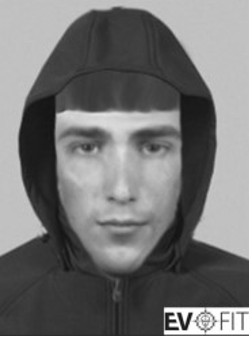
Gardaí in Ballymun are investigating a burglary that took place in Willow Park Avenue, Glasnevin, Dublin 9 between 4.45 and 5.45 pm on 14 November 2023.
On the date in question the victim left her house to do some shopping. On her way back she was stopped by a man who told her she had forgotten something in the shop. She returned to the shop and discovered that nothing had been left behind.
When she returned home the victim reported a burglary at her home and that a significant amount of cash had been taken.
Suspect Description:
- Male in his early 30’S
- 5’7- 5’8 in height
- Thin build
- Dublin accent
- Small eyes
- Brown hair
- Navy/ black puffy jacket

Gardaí in Carrigtwohill Garda Station are investigating a serious assault that took place in Tibbotstown, Carrigtwohill, Co. Cork, at approximately 10am on 12th November 2023.
On the date in question the victim came across three men who claimed to be hunting foxes with their dogs on his land. The injured party asked the men to leave his land when the first suspect hit him with a T-bar, causing two serious injuries to his head. The second suspect subsequently hit the injured party a number of times with a shovel. The three men then left in a black-coloured 4 x4 type vehicle.
The victim was brought by ambulance to Cork University Hospital for treatment where he received 17 staples to his head.
Suspects’ Descriptions:
Suspect No. 1
- Height - Approximately 6ft
- Build - Lean
- Aged in his 40’s
- Brown top with brand name Ridgeline
- Two dogs with him, a Jack Russell terrier and a crossbreed between a poodle and a Scottish Highland terrier white curly hair.
- Possession of a T-Bar
Suspect No. 2
- Height - Approximately 5ft 5
- Build - Medium
- Receding hairline, grey and red in colour
- Carried a shovel
Suspect No. 3
- Height - Approximately 5ft5
- Build - Heavy
- Red short hair
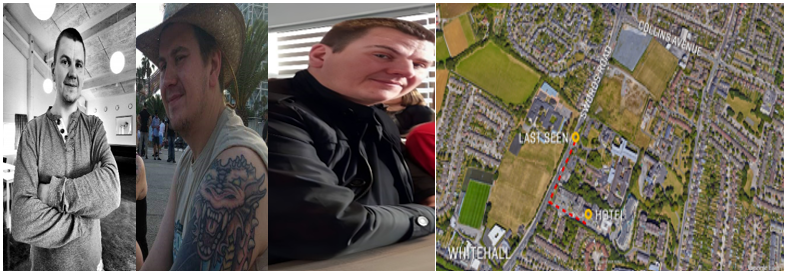
Gardaí at Ballymun Garda Station are investigating the disappearance of forty-one-year-old Jon Jonsson, last seen Saturday 9th February 2019.
Jon, originally from Iceland, travelled to Ireland on Friday 8th and checked into the Bonnington Hotel, where a poker tournament was taking place. On Saturday, Jon was joined by his partner, who was also attending the tournament. Jon’s partner left their bedroom on Saturday morning to get a coffee, followed shortly afterwardsby Jon, who was captured on the hotel’s CCTV in the lobby. Jon left the hotel and turned right onto the Swords road in the direction of the Airport. Jon left his passport and phone behind in the hotel room.
A number of Operational searches which took place in North Dublin this week have yielded no further information on the whereabouts of Jon Jonsson.
It is out of character for Mr Jonsson to go missing like this. He is a family man with young children back at home in Iceland. His partner, family and friends are extremely concerned for his safety and wellbeing and are appealing to the public for their assistance.
The Garda investigation into the disappearance of Jon has also continued over the last 5 years. The investigation to date has created over 270 jobs/lines of enquires and numerous statements have been taken and hours of CCTV were reviewed. Despite ongoing investigations and enquiries, Jon has yet to be located and we continue to look for your help.
Garda Appeal:
- Jon Jonsson was last seen on the Swords Road walking in the direction of the junction with Collins Avenue, Whitehall at 11.07am on 09/02/2019.
- The investigation team received two items of anonymous correspondence in early February 2024, the contents of which have been assessed. Are you the author or do you know the author(s) of this correspondence?
- The Garda investigation team are continuing to appeal to the author(s) of those correspondences to make direct contact with them. Any contact will be treated with sensitivity and compassion. Your assistance could be very important.
- Were you at the Bonnington Hotel on the night of 8th Feb and morning of 9th Feb 2019? Did you come into contact with Jon? While it is 5 years since Jon went missing, this was a high profile case and therefore you might remember being there.
- Can you assist with this investigation? Maybe we have spoken to you previously and for whatever reason you felt unable to assist - but now feel that you can. We would like to encourage you to please do so now, no matter how insignificant you think the information you have to offer may be.

Gardaí at Mallow Garda Station continue to investigate all the circumstances surrounding the death of thirty-six-year-old Peter Murphy, whose remains were found on Saturday, February 7th 2015, at a rented property at Shanavoher, Bweeng, Mallow, Co. Cork.
At approximately 1.10pm, Mallow Gardaí received a call that there was broken glass outside the front door of the property. Gardaí attending the scene discovered Peter’s remains located in the house. A subsequent post mortem examination revealed that he had died as a result of having received serious injuries.
Peter maintained regular contact with his family and a close circle of friends - speaking with members of his family a number of times during the course of any day. Thursday, the 5th February 2015 was no different as Gardaí have established that the last contact Peter had with family and friends was on this date.
At 11.30am on Saturday 7th, a person walking past the house noticed broken glass in front of the hall door. Contact was made with the landlord who on inspection discovered Peter’s remains and notified Gardaí.
Garda Appeal:
- We are very grateful for all those who have come forward and assisted with the investigation and provided information during the intervening years. However, we still require your help, and it is never too late to come forward and help bring closure for Peter’s family. Please be assured that any assistance will be treated with sensitivity and compassion.
- The focus of our appeal is to a specific small circle of people who have information that can assist with this murder investigation.
- We together with Peter’s family are appealing to those individuals to look into their conscience and unburden themselves of whatever information they may have - no matter how small or insignificant they might believe it to be.
- We believe that the key to progressing this investigation remains within the local community. Peter’s death will have been a talking point over the years and you may hold that critical piece of information.
- Peter’s family remain devastated by this terrible crime and are still struggling to come to terms with his death. We together with Peter’s family are appealing for your help. It has been 9 years since and during that time your relationships, associations, loyalties may have changed. You may not now be constrained by the set of circumstances that existed for you back in 2015, and therefore feel better placed to unburden yourself.
Driving a vehicle is one of the most dangerous activities we will do on a regular basis. It is of paramount importance that drivers take personal responsibility to ensure their vehicle is in a roadworthy condition and that they are familiar with the controls of the car.
It is not enough that your car has a valid NCT disc on the windscreen. A vehicle needs to be serviced in line with manufacturer’s recommendations in between roadworthiness tests as well. It’s your legal obligation to do so. Unfortunately, some motorists continue to think that once their car passes the NCT it doesn’t need to be serviced until the next test or until a warning light comes on.
Obviously, it is not expected of drivers to have an intricate knowledge of the internal workings of the vehicle, however below is a list of things that drivers do need to be aware of and check at regular intervals:
Tyres
Tyres are the only point of contact between you and the road so it is vital that they are maintained correctly. You should regularly check each tyre for:
- Defects such as bulges, sidewall tears, exposed wire or penetration damage
- Tyre thread depth. The legal limit is 1.6mm but it is recommended that they are changed at 3mm
It is an offence to drive a vehicle in a public place with a tyre thread depth of less than 1.6mm. A Fixed Penalty Notice of €80 and 2 penalty points can be issued.
Lights
Drivers should do a walk around of their vehicle regularly to ensure all lights are working correctly. If any lights are faulty, the bulbs should be replaced immediately as it is an offence to drive a vehicle on a public road with faulty lights.
Since 1st November 2014, all vehicles sold in the EU must be fitted with Day Running Lights or DRL’s. DRL’s are only to the front and the rear of the vehicle is not illuminated. While this is a good safety initiative, it has created a problem with drivers failing to turn on their dipped headlights during the hours of darkness. Drivers need to ensure they activate their dipped headlights during dusk, darkness and adverse weather conditions such as heavy rainfall or snow, to ensure the vehicles tail lights are illuminated and they have sufficient light to the front.

Engine oil
As all drivers should be aware, oil is crucial for an engine to function properly. While this should be checked by a mechanic during a vehicle’s routine service, it is good practice to check your car’s oil level on a regular basis, particularly before setting off on long journeys or taking your car overseas.
Fluids
Under the bonnet of a car, there are a number of containers for different fluids such as power steering fluid, coolant, windscreen wash etc. These are all clearly marked and will have minimum and maximum levels marked on the containers as appropriate. It is good practice to visually check these levels regularly.
Windscreen Wipers
Windscreen Wipers typically last between 1 to 2 years depending on frequency of use. If your wipers are not performing as they should, don’t wait until the next service to change them.
Safety Kit
It is highly recommended that you carry the following in your vehicle:
- High visibility vest
- A working torch
- A hazard warning triangle
- De-icing equipment (for glass and door locks)
- First aid kit
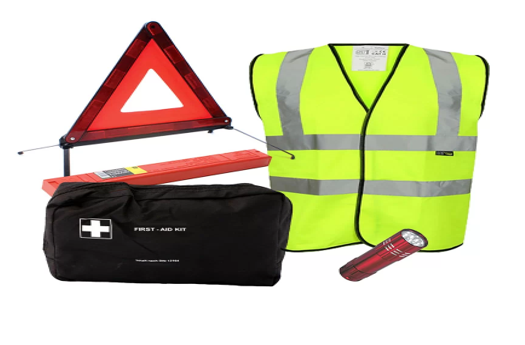
Warning Lights
Don’t ignore dashboard warning lights. If a warning is present, as a general rule, yellow lights mean ‘check as soon as possible’, red means ‘stop vehicle as soon as it is safe to do so’.
Some common examples are:
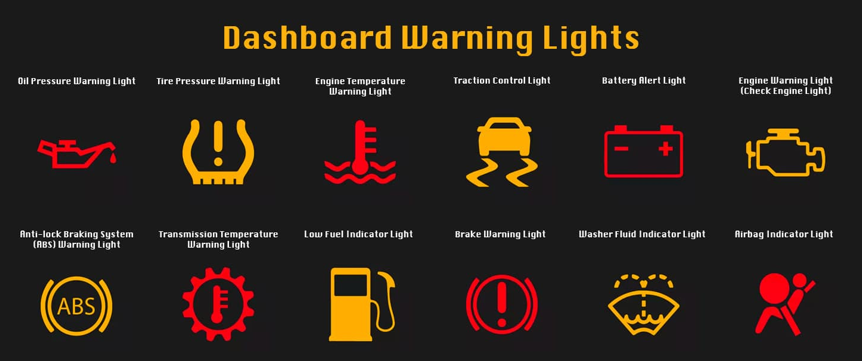

The Gardaí at Salthill Garda Station are appealing for information in relation to the discovery of human remains at 158 Upper Salthill on the 17th April 2002.
The owner of this property was carrying out excavation work in the back garden and discovered human remains wrapped up in a sleeping bag buried in a shallow grave. There were also a number of items of clothing including, boots, jewellery and hair ties in the sleeping bag.
A full examination of the scene was carried out and a post mortem on the remains. An investigation was launched with Gardaí establishing that this property was used as a squat over the years by a number of people. Their enquiries led them to a man known as “Dave”, who busked around Galway, particularly on Shop Street, an area known locally as “the four corners”. He played guitar and tin whistle. He always had his pet collie dog with him.
Gardaí believe Dave was originally from the United Kingdom and the last known sighting of him was in 1999. Gardaí believe he was buried at 158 Upper Salthill almost two years before his remains were discovered. Gardaí also believe he may have been known as “Dave Rawson” or “Dave Tang”, but are unsure if that was his real name.
Appeal:
- Can you assist with identifying Dave?
- Were you living in Galway back in 1999 when it is believed Dave Tang died? Did you know him or any of his friends / associates?
- Housemates described him making phone calls to family in England, possibly in the Exeter area, using numbers in his black notebook. There was also information connecting him to the Tunbridge Wells and Cornwall areas of Southern England.
- His dog licence was registered under the name ‘Dave Rawson’ – unfortunately this may not have been his real name and hasn’t yielded any positive results.
- If you feel that you can assist Gardaí after all these years, please get in touch. We would like to assure you that you will be treated with the utmost sensitivity and compassion.
Description of Dave:
- He was a well-established figure on the busking scene in Galway, often playing the guitar in and around Lynch’s Castle on Shop Street.
- He was very recognisable – carried around a black notebook and wore bangles on his wrists – he had a sort of ‘New Age’ appearance/style of dress.
- Collie dog he would walk on a blue nylon rope and wore Northridge boots.
- He was a very good musician – It is thought he may have been classically trained and well-educated.
